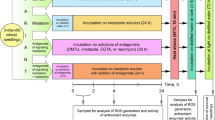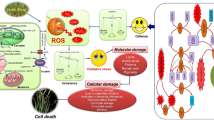Abstract
Nitric oxide (NO) is a bioactive gaseous, multifunctional molecule playing a central role and mediating a variety of physiological processes and responses to biotic and abiotic stresses including heavy metals. The present study investigated whether NO applied exogenously as sodium nitroprusside (SNP) has a protective role against arsenic (As) toxicity (applied as sodium arsenate) in Vigna radiata (mung bean) germinating seeds. Treatment with 75 μM SNP significantly improved mung bean seed germination, growth, and decreased the As-accumulation. Furthermore, As-induced oxidative stress measured in terms of malondialdehyde and H2O2 contents was lesser upon supplementation of SNP indicating a reactive oxygen species scavenging activity of NO. In addition, supplementation of SNP markedly decreased the activity of superoxide dismutase and stimulated catalase, α-amylase, protease and slightly changed the H+-ATPase activity.



Similar content being viewed by others
References
Abedin MJ, Meharg AA (2002) Relative toxicity of arsenite and arsenate on germination and early seedling growth of rice (Oryza sativa L.). Plant Soil 243:57–66
Ashraf MY, Sadiq R, Hussain M, Ashraf M, Ahmad, MSA (2011) Toxic effect of nickel (Ni) on growth and metabolism in germinating seeds of sunflower (Helianthus annuus L.). Biol Trace Element Res (Online publication date 15 Jan)
Ahsan N, Lee D, Lee S, Kang KY, Lee JJ, Kim PJ, Yoon H, Kim J, Lee B (2007) Excess copper induced physiological and proteomic changes in germinating rice seeds. Chemosphere 67:1182–1193
Ahsan N, Lee D, Kim K, Alam I, Lee S, Lee K, Lee H, Lee B (2010) Analysis of arsenic stress-induced differentially expressed proteins in rice leaves by two-dimensional gel electrophoresis coupled with mass spectrometry. Chemosphere 78:224–231
Beligni MV, Lamattina L (2000) Nitric oxide stimulates seed germination and de-etiolation and inhibits hypocotyl elongation, three light-inducible responses in plants. Planta 210:215–221
Bethke PC, Libourel IG, Aoyama N, Chung YY, Still DW, Jones RL (2007) The Arabidopsis aleurone layer responds to nitric oxide, gibberellin, and abscisic acid and is sufficient and necessary for seed dormancy. Plant Physiol 143:1173–1788
Bradford MM (1976) A rapid and sensitive method for the quantitation of microgram quantities of protein utilizing the principle of protein dye binding. Anal Biochem 72:248–254
Cao X, Ma LQ, Tu C (2004) Antioxidative responses to arsenic in the arsenic-hyperaccumulator Chinese brake fern (Pteris vittata L.). Environ pollut 128:317–325
Carbonell Barrachina A, Burlo CF, Mataix BJ (1995) Arsenic uptake, distribution, and accumulation in tomato plants: effect of arsenic on plant growth and yield. J Plant Nutr 18:1237–1250
Carbonell-Barrachina AA, Aarabi MA, Delaune RD, Gambrell RP, Patrick WH Jr (1998) The influence of arsenic chemical form and concentration on Spartina patens and Spartina alterniflora growth and tissue arsenic concentration. Plant Soil 198:33–43
Choudhury B, Mitra S, Biswas AK (2010) Regulation of sugar metabolism in rice (Oryza sativa L.) seedlings under arsenate toxicity and its improvement by phosphate. Physiol Mol Biol Plants 16:59–68
Cliffe AJ, Law BA (1982) A new method for the detection of microbial proteolytic enzyme in milk. J Dairy Res 49:209–219
Cui XM, Zhang YK, Wu XB, Liu CS (2010) The investigation of the alleviated effect of copper toxicity by exogenous nitric oxide in tomato plants. Plant Soil Environ 56:274–281
De Pinto MC, Tommasi F, De Gara L (2002) Changes in the antioxidant systems as part of the signaling pathway responsible for the programmed cell death activated by nitric oxide and reactive oxygen species in tobacco bright yellow 2 cells. Plant Physiol 130:698–708
De Pinto MC, Paradiso A, Leonetti P, De Gara L (2006) Hydrogen peroxide, nitric oxide and cytosolic ascorbate peroxidase at the crossroad between defence and cell death. Plant J 48:784–795
Dua A, Sawhney SK (1991) Effect of chromium on activities of hydrolytic enzymes in germinating pea seeds. Environ Exp Bot 31:133–139
Gong H, Zhu X, Chen K, Wang S, Zhang C (2005) Silicon alleviates oxidative damage of wheat plants in pots under drought. Plant Sci 169:313–321
Gupta M, Sharma P, Sarin NB, Sinha AK (2009) Differential response of arsenic stress in two varieties of Brassica juncea L. Chemosphere 74:1201–1208
Habib N, Ashraf M, Ahmad MSA (2010) Enhancement in seed germinability of rice (Oryza sativa L.) by pre-sowing seed treatment with nitric oxide (NO) under salt stress. Pak J Bot 42:4071–4078
He YK, Tang RH, Hao Y, Stevens RD, Cook CW, Ahn SM, Jing L, Yang Z, Chen L, Guo F, Fiorani F, Jackson RB, Crawford NM, Pei ZM (2004) Nitric oxide represses the Arabidopsis floral transition. Science 305:1968–1971
Hogg N, Kalyanaraman B (1999) Nitric oxide and lipid peroxidation. Biochem Biophys Acta 1411:378–384
Hsu YT, Kao CH (2004) Cadmium toxicity is reduced by nitric oxide in rice leaves. Plant Growth Regul 42:227–238
Hu K, Hu LY, Li YH, Zhang FQ, Zhang H (2007) Protective roles of nitric oxide on germination and antioxidant metabolism in wheat seeds under copper stress. Plant Growth Regul 53:173–183
Jha AB, Dubey RS (2004) Carbohydrate metabolism in growing rice seedlings under arsenic toxicity. J Plant Physiol 161:867–872
Jin J, Xu Y, Huang Y (2010) Protective effect of nitric oxide against arsenic-induced oxidative damage in tall fescue leaves. Afr J Biotechnol 11:1619–1627
Khan I, Ahmad A, Iqbal M (2009) Modulation of antioxidant defence system for arsenic detoxification in Indian mustard. Ecotoxicol Environ Saf 72:626–634
Kopyra M, Gwozdz EA (2003) Nitric oxide stimulates seed germination and counteracts the inhibitory effect of heavy metals and salinity on root growth of Lupinus luteus. Plant Physiol Biochem 41:1011–1017
Labra M, Gianazza E, Waitt R, Eberini I, Sozzi A, Regondi S, Grassi F, Agradi E (2006) Zea mays L. protein changes in response to potassium dichromate treatments. Chemosphere 60:1234–1244
Laemmli UK (1970) Cleavage of structural proteins during the assembly of the head of bacteriophage T4. Nature 227:680–685
Laspina NV, Groppa MD, Tomaro ML, Benavides MP (2005) Nitric oxide protects sunflower leaves against Cd-induced oxidative stress. Plant Sci 169:323–330
Latif HH (2010) The influence of nickel sulphate on some physiological aspects of two cultivars of Raphanus sativus L. Arch Biol Sci Belgrade 62:685–693
Liu X, Zhang S, Shan X, Zhu Y (2005) Toxicity of arsenate and arsenite on germination, seedling growth and amylolytic activity of wheat. Chemosphere 61:293–301
Loureiro S, Santos C, Pinto G, Costa A, Monteiro M, Nogueira AJA, Soares AMVM (2006) Toxicity assessment of two soils from Jales Mine (Portugal) using plants: growth and biochemical parameters. Arch Environ Contam Toxicol 50:182–190
Mahimairaja S, Bolan NS, Adriano DC, Robinson B (2005) Arsenic contamination and its risk management in complex environmental settings. Adv Agron 86:1–82
Meharg AA, Hartley-Whitaker J (2002) Arsenic uptake and metabolism in arsenic resistant and non-resistant plant species. New Phytol 154:29–43
Meharg AA, Jardine L (2003) Arsenite transport into paddy rice (Oryza sativa) roots. New Phytol 157:39–44
Neumann D, Lichtenberger O, Tschiersch K, Nover L (1994) Heat-shock proteins induce heavy-metal tolerance in higher plants. Planta 194:360–367
Panda SK, Upadhyay RK, Nath S (2010) Arsenic stress in plants. J Agron Crop Sci 196:61–174
Parani M, Rudrabhatia S, Myers R, Weirich H, Smith B, Leaman DW, Goldman SL (2004) Microarray analysis of nitric oxide responsive transcripts in Arabidopsis. Plant Biotech J 2:359–366
Rios-Gonzalez K, Erdei L, Herman S (2002) The activity of antioxidant enzymes in maize and sunflower seedlings as affected by salinity and different nitrogen sources. Plant Sci 162:923–930
Romero-Puertas MC, Perazzolli M, Zago ED, Delledonne M (2004) Nitric oxide signaling functions in plant–pathogen interactions. Cell Microbiol 6:795–803
Shaibur MR, Kawai S (2010) Effect of arsenic on nutritional composition of Japanese mustard spinach: an ill effect of arsenic on nutritional quality of a green leafy vegetable. Nat Sci 8:186–194
Shri M, Kumar S, Chakrabarty D, Trivedi PK, Mallick S, Misra P, Shukla D, Mishra S, Srivastava S, Tripathi RD, Tuli R (2009) Effect of arsenic on growth, oxidative stress, and antioxidant system in rice seedlings. Ecotoxicol Environ Saf 72:1102–1110
Singh HP, Batish DR, Kohlo RK, Arora K (2007) Arsenic-induced root growth inhibition in mung bean (Phaseolus aureus Roxb.) is due to oxidative stress resulting from enhanced lipid peroxidation. Plant Growth Regul 53:65–73
Singh HP, Batish DR, Kaur G, Arora K, Kohli RK (2008) Nitric oxide (as sodium nitroprusside) supplementation ameliorates Cd toxicity in hydroponically grown wheat roots. Environ Exp Bot 63:158–167
Singh HP, Kaur S, Batish DR, Sharma VP, Sharma N, Kohli RK (2009) Nitric oxide alleviates arsenic toxicity by reducing oxidative damage in the roots of Oryza sativa (rice). Nitric Oxide 20:289–297
Srivastava M, Ma LQ, Singh N, Singh S (2005) Antioxidant responses of hyperaccumulator and sensitive fern species to arsenic. J Exp Bot 56:1335–1342
Steel RC, Torrie JH (1980) Principles and procedures of statistics, 2nd edn. Mc Graw Hill, New York
Stoeva N, Berova M, Zlatev Z (2003/4) Physiological response of maize to arsenic contamination. Biol Plant 47:449–452
Swain RR, Dekker EE (1966) Seed germination studies. I. Purification and properties of an α-amylase from the cotyledons of germinating peas. Biochim Biophys Acta 122:75–86
Tripathi RD, Srivastava S, Mishra S, Singh N, Tuli R, Gupta DK, Maathuis FJM (2007) Arsenic hazards: strategies for tolerance and remediation by plants. Trends Biotechnol 25:158–165
Valentovič P, Luxova M, Kolarovic L, Gasparikova O (2006) Effect of osmotic stress on compatible solutes content, membrane stability and water relations in two maize cultivars. Plant Soil Environ 52:186–191
Van Assche F, Clijsters H (1990) Effects of metals on enzyme activity in plants. Plant Cell Environ 13:195–206
Van den Broeck K, Vendecasteele C, Geuns JMC (1998) Speciation by liquid chromatography-inductively coupled plasma-mass spectrometry of arsenic in mung bean seedlings used as a bio-indicator for the arsenic contamination. Anal Chim Acta 361:101–111
Velikova V, Yordanov I, Edreva A (2000) Oxidative stress and some antioxidant system in acid rain treated bean plants: protective role of exogenous polyamines. Plant Sci 151:59–66
Wang YS, Yang ZM (2005) Nitric oxide reduces aluminum toxicity by preventing oxidative stress in the roots of Cassia tora L. Plant Cell Physiol 46:1915–1923
Wang W, Vinocur B, Shoseyov O, Altman A (2004) Role of plant heat shock proteins and molecular chaperons in the abiotic stress response. Trends Plant Sci 9(5):1360–1385
Wollgiehn R, Neumann D (1999) Metal stress response and tolerance of cultured cells from Silene vulgaris and Lycopersicon peruvianum: role of heat stress proteins. J Plant Physiol 154:547–553
Xiong J, Fu G, Tao L, Zhu C (2010) Roles of nitric oxide in alleviating heavy metal toxicity in plants. Arch Biochem Biophys 497:13–20
Yu CC, Hung KT, Kao CH (2005) Nitric oxide reduces Cu toxicity and Cu-induced NH4 + accumulation in rice leaves. J Plant Physiol 162:1319–1330
Zenoff AM, Hilal M, Galo M, Moreno H (1994) Changes in roots lipid composition and inhibition of the extrusion of proton during salt stress in two genotypes of soybean resistant or susceptible to stress. Plant Cell Physiol 35:729–735
Zhang H, Shen WB, Zhang W, Xu LL (2005) A rapid response of β-amylase to nitric oxide but not gibberellins in wheat seeds during the early stage of germination. Planta 220:708–716
Author information
Authors and Affiliations
Corresponding author
Additional information
Communicated by S. Weidner.
Rights and permissions
About this article
Cite this article
Ismail, G.S.M. Protective role of nitric oxide against arsenic-induced damages in germinating mung bean seeds. Acta Physiol Plant 34, 1303–1311 (2012). https://doi.org/10.1007/s11738-012-0927-9
Received:
Revised:
Accepted:
Published:
Issue Date:
DOI: https://doi.org/10.1007/s11738-012-0927-9




